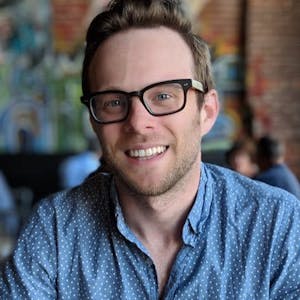Talks from our events
Latest
All talksVanilla Server Components React Advanced 2025
React Advanced 2025
24 min
Vanilla Server Components

Krasnzony discusses the introduction of vanilla Server Components inspired by React Summit, focusing on challenges of using components outside a framework. The talk emphasizes improving user experience in React apps through HTTP streaming, sending data to the browser with script tags, and implementing asynchronous components for server-side rendering. Enhancements to React rendering include the pipeable string API for data rendering and server-side dynamic rendering transitioning to client-side interactivity. Challenges in supporting server components and transitioning to server-oriented components are also explored.
How I Hacked React Native DevTools (And Built a Plugin Framework) React Advanced 2025
React Advanced 2025
20 min
How I Hacked React Native DevTools (And Built a Plugin Framework)

Simon explains the necessity of a custom React Native DevTools plugin framework due to the limitations of existing tools like Flipper and the lack of plugin support in React Native DevTools. Szymon Chmal, React Native expert at Callstack, explains the constraints of the custom DevTools framework plugin and the unique characteristics of React Native DevTools. The implementation involves bundling code via npm & Metro, using Chrome DevTools protocol for communication, and customizing DevTools frontend and middleware with Rosenite. Further customization includes injecting middleware for UI, adding custom scripts for dynamic content, accessing DevTools UI API for creating custom panels, bridging communication between plugins, and exploring the Resonight network activity plugin for inspecting headers and responses.
They Said JavaScript Couldn't Make Beautiful Art – They Were Wrong JSNation US 2025
JSNation US 2025
31 min
They Said JavaScript Couldn't Make Beautiful Art – They Were Wrong

The Talk delves into JavaScript artwork creation, debunking misconceptions and exploring its evolution from basic animation to advanced web development innovations. It discusses the development of animation technologies in JavaScript, comparing Canvas and WebGL, and emphasizes the diversity of tools available. The session focuses on using Canvas Sketch for creating custom and abstract designs, detailing rendering, saving points, working with coordinates and styles, and utilizing animation for interactivity. It also covers specifying animation parameters and exploring options for connectivity.
Automatic and Accessible Dynamic Themes With OKLCH Color Space React Advanced 2025
React Advanced 2025
18 min
Automatic and Accessible Dynamic Themes With OKLCH Color Space

Talk on building dynamic themes using Ocale CH ColorSpace. Personalized UI colors enhance user engagement and product uniqueness. Dynamic theming simplicity and challenges with RGB, HEX, and HSL color formats. KLCH color space: uniform lightness, simple modifications, and high accessibility. KLCH works like HSL but encodes lightness better, enabling practical dynamic theme implementation with CSS. Define lightness values visually for a custom palette mirroring tailwind CSS. Determine chroma for consistency using KLSH formula and user-selected hue. Check hue, adjust lightness and chroma for consistency. Develop Simple Hue Picker for hue selection. Transfer new colours into Tailwind CSS or use other CSS approaches. Use Colory Library for colour calculations.
Frontend Internationalization That Reads Like English (Thanks, gettext!) React Summit US 2025
React Summit US 2025
19 min
Frontend Internationalization That Reads Like English (Thanks, gettext!)

Henry Lee presents a frontend internationalization approach using React and discusses challenges in naming keys for translations. The Talk addresses issues with naming keys in JSON dictionaries, refactoring keys to eliminate translation challenges using GNU GetTex, exploring GetTex workflow for efficient localization with Lingui, defining messages and extraction with Lingui workflow, optimizing Lingui compilation and translation, enhancing Lingui features for translation, and encouraging Lingui adoption for projects by addressing reasons for underutilization and promoting trial and migration.
Design to Code Using a Custom Design System with AI React Summit US 2025
React Summit US 2025
19 min
Design to Code Using a Custom Design System with AI

Chaitanya, Principal Engineer at Atlassian, discusses the design system at Razorpay, the impact of AI on UI development, and the integration of AI with design systems for enhanced productivity. Detailed prompts for AI to build UI components can be cumbersome. Imagine a seamless process where AI interprets Figma designs to create UI. Leveraging design expertise and focusing on business logic, not writing detailed AI prompts. Blade's MCP server facilitates the magic of transforming Figma designs into UI code by collaborating with Figma and OpenAI.
A JavaScript Less Future - New Browser APIs and Their Impact on the Future of React Development React Summit US 2025
React Summit US 2025
21 min
A JavaScript Less Future - New Browser APIs and Their Impact on the Future of React Development

Introduction to JavaScript Less Future, impact of new browser APIs on front-end development, S&C Electric Company overview, shift towards less JavaScript, historical perspective of web development challenges, importance of browser APIs in modern development, focus on key browser APIs for enhanced user experiences, demonstration of date picker functionality. Exploring Date Picker Functionality with Code Integration and Browser APIs. Closing Panel and Utilizing New Browser APIs for Date Time Picker. Controlling Date Time Picker Panel Position with New Browser APIs. Customizing Date Range Styling with CSS and Anchor API. Animating Date Range Picker with View Transitions and CSS Attributes. Developing Text Formatter with Dual Layers and Event Handling. Developing Plain Text Only Content Editable Layer with Highlighting API. Applying Styles with CSS Selector and Color API.
Automated Accessibility Testing in React: Beyond the Basics React Advanced 2025
React Advanced 2025
9 min
Automated Accessibility Testing in React: Beyond the Basics

Introduction to Accessibility Testing in React applications, emphasizing early automation and challenges in scaling. Importance of instant feedback, Unity test, and entry testing for code accessibility. Utilizing end-to-end testing tools like Jest-Axi and Cypress to ensure accessibility compliance. Emphasis on manual testing alongside automated tools. Encouragement for discussions on LinkedIn to enhance accessibility knowledge.
React Components for both the Client & the Server React Summit US 2025
React Summit US 2025
16 min
React Components for both the Client & the Server

Kiko shares the process of building UI components for both client and server sides, highlighting performance benefits and challenges of using server components. Building a reusable UI library with server and client components, aiming for similarity and adaptability. Adding interactivity to a data table in a Next.js application by incorporating client components for reactivity and customization. Building customization by incorporating a custom cell, resolving errors between client and server components, and optimizing syntax highlighting and markdown processing. Achieving composition pattern at the component level by separating client and server parts, maintaining an agnostic component part, and optimizing rendering for client-specific functionalities. Achieving client-server performance optimization by keeping rendering tree agnostic, enabling separate client component extraction, and promoting interactivity within components.
lynx-ui: Best Lynx in Components React Advanced 2025
React Advanced 2025


30 min
lynx-ui: Best Lynx in Components



2 authors
Shun discusses challenges in building React components for production, especially for mobile web; explores building complex mobile apps like TikTok with LYNX technology; introduces Lynx UI components for native user experiences; showcases customizable interactions with Lynx UI, including custom animation with MTS logic; demonstrates building composable dialog components and customizable design integration; extends Design System to TikTok with MotionJS adaptation and sponsorship announcement; introduces LYNX UI Theme LUNA and upcoming multi-platform app release.
Featured
I Measured React Server Components’ Performance So You Don’t Have To React Advanced 2025
React Advanced 2025
22 min
I Measured React Server Components’ Performance So You Don’t Have To

Nadia introduces React server components and performance, highlighting the benefits of server components in improving performance and the need for a clear understanding of their impact on rendering and data fetching in React applications. Exploring Server-Side Rendering Impact on Performance: Analysis of transitioning from client-side to server-side rendering, including implications on performance and data fetching. Transforming Empty Screen to Performance Improvement: Detailed process of browser work, React rendering, and data fetching impact. Making the Shift to Server-Side Rendering: Impact on interactivity and data fetching optimization. Understanding the Benefits of AppRouter Version in SSR with Reduced JavaScript Payload and Introduction of Server Components. Investigating Smarter Server-Side Rendering with Server Components and Streaming in Next.js. Refactoring for Server Components: Async Data Fetching, Server Component Identification, and Utilizing Suspense for React Streaming Chunks. Enhancing Performance with Server Components: Balancing Rendering Approaches, Importance of Server-Side Data Fetching, and Leveraging Suspense for Improved Streaming.
Motion Control With Multimodal LLMs JSNation 2025
JSNation 2025
39 min
Motion Control With Multimodal LLMs

The Talk delves into motion control with multimodal AI, exploring TensorFlow.js models for gesture recognition and enhancing user interactions. It discusses leveraging LLMs for gesture-based interaction, investigating Gemiini for gesture recognition, and controlling light states with Gemini functions. The conversation includes webcam-based gesture recognition, custom gesture databases, and the future of personalized AI assistance with acoustic recognition.
Frontend’s Lost Decade and the Performance Inequality Gap JSNation 2025
JSNation 2025
32 min
Frontend’s Lost Decade and the Performance Inequality Gap
Top Content

Alex Russell's journey from engineering to product management, the focus on improving web experiences, and optimizing software for end-user success. Considerations include device performance, web diversity, and API constraints. Challenges of web platforms encompass hardware and network limitations, prioritizing user experience. Understanding the impact of Moore's Law on device performance and adapting browsers for efficiency. Emphasis on code optimization, user-focused development, and quality in web UI. Addressing challenges in PWA success, developer learning, and balancing frameworks with platform understanding.
The AI-Native Software Engineer JSNation US 2025
JSNation US 2025
35 min
The AI-Native Software Engineer

Software engineering is evolving with AI and VIBE coding reshaping work, emphasizing collaboration and embracing AI. The future roadmap includes transitioning from augmented to AI-first and eventually AI-native developer experiences. AI integration in coding practices shapes a collaborative future, with tools evolving for startups and enterprises. AI tools aid in design, coding, and testing, offering varied assistance. Context relevance, spec-driven development, human review, and AI implementation challenges are key focus areas. AI boosts productivity but faces verification challenges, necessitating human oversight. The impact of AI on code reviews, talent development, and problem-solving evolution in coding practices is significant.
Vite and the Future of JavaScript Tooling JSNation 2025
JSNation 2025
23 min
Vite and the Future of JavaScript Tooling
Top Content

Evan Yeo discusses Vite's growth, challenges with dependencies like ES Build and Rollup, and the creation of the bundler Rolldown. The JavaScript ecosystem faces fragmentation, but the company aims for a unified JavaScript stack. Rust is chosen for lower-level development, while JavaScript and TypeScript for high-level APIs. Roldown offers advanced bundling features, outperforming existing tools. Integration with Vite leads to tailored optimizations and significant speed improvements. Vite+ development focuses on creating a comprehensive toolkit. VitePlus integrates TS-down for library bundling, ViteTest for testing, and OX-Lint for linting. Future plans include monorepo awareness, build orchestration, and framework-like features.
Rethinking Bundling: Why You Don’t Need Less JavaScript JSNation US 2025
JSNation US 2025
30 min
Rethinking Bundling: Why You Don’t Need Less JavaScript

The speaker, Daniel, shares insights on his role as an open source maintainer, projects Nuxt and Nitro, and living in Edinburgh. Nuxt, a full-stack framework, evolved with community support, emphasizing community-driven development. Optimization strategies for JavaScript, CSS, and font loading in Nuxt were discussed. Integration of Nuxt Scripts for web performance, challenges in meta framework development, and considerations for Nuxt V3 rewrite were highlighted. Future plans include smoother migrations and open-source access to emoji slides integration.
The State of the Web JSNation 2025
JSNation 2025
32 min
The State of the Web

Sasha Grief discusses the state of the web through web development surveys, leading to an interactive quiz about the state of JS and usage of front end frameworks. Discussion on popular front-end libraries like React, Vue, Angular, and the rising popularity of TypeScript among developers in recent surveys. Discussion on TypeScript adoption, TC39 committee proposals, favorite CSS feature 'has,' and browser support for 'has' selector. Browser interoperability, browser vendors' initiatives, AI usage among web developers, and survey insights. Job titles linked to higher income, diversity of survey topics, top hobby among developers, and popular specific video games. Learnings on CSS features, TypeScript default, AI usage, survey benefits, challenges in reaching diverse survey participants. Surprising positivity in JavaScript usage, stable framework landscape, AI adoption challenges, mainstream AI tools, successful situp.js survey. Inconsistent respondent numbers, manual data normalization efforts, subjective question selection process, community input, mitigation of selection bias. Reason for starting surveys, transition from Meteor JS, exploration of JavaScript ecosystem.
Keeping Up with The Fast and Furious Web JSNation US 2025
JSNation US 2025
29 min
Keeping Up with The Fast and Furious Web

Scott Talinsky's journey in web development highlights his transition from YouTube tutorials to creating educational content and courses, reflecting his passion for teaching. The evolution of web development tools showcases advancements from limited colors to modern frameworks like React and CSS features like squircles. Adapting to new technologies emphasizes core skills and freedom in tool selection. User-centric development prioritizes accessibility and understanding the purpose of tools. Learning strategies focus on fundamentals, hands-on learning, and avoiding influencer bias. Standing out in tech roles requires quality projects, broad knowledge, and effective communication.
Thinking Like an Architect Node Congress 2025
Node Congress 2025
31 min
Thinking Like an Architect
Top Content

In modern software development, architecture is more than just selecting the right tech stack; it involves decision-making, trade-offs, and considering the context of the business and organization. Understanding the problem space and focusing on users' needs are essential. Architectural flexibility is key, adapting the level of granularity and choosing between different approaches. Holistic thinking, long-term vision, and domain understanding are crucial for making better decisions. Effective communication, inclusion, and documentation are core skills for architects. Democratizing communication, prioritizing value, and embracing adaptive architectures are key to success.
Never Worry About CORS Again JSNation US 2025
JSNation US 2025
28 min
Never Worry About CORS Again

Talk on Bund: Overview of Bund, its speed optimization, components like runtime, package manager, test runner, and bundler. Efficient features include fast npm manager, pnpm lockfile support, Jest-compatible test runner, and optimized runtime components. Built-in features like modern password hashing, WebSocket server, file glob API, and database clients. API design focuses on common use cases and optimization. Enhanced JavaScript functionality with SIMD, native code, and performance improvements. Challenges in JavaScript productivity, BUN adoption, deployment, and support. React support, community involvement, security, Next.js compatibility, and transition.
Trending today
TanStack Start 1.0 - A New Full Stack Framework for React and Friends React Summit US 2025
React Summit US 2025
29 min
TanStack Start 1.0 - A New Full Stack Framework for React and Friends

The speaker introduces Tanstack Start, emphasizing type safety for better development experiences. Tanstack Start offers a client-first approach with seamless server-side integration. Tanstack Router provides server-side solutions like SSR and API routes. The demo showcases Tanstack CLI usage and server functions. Tanstack Start enables isomorphic code with server-only logic. Enhanced data validation and URL state management are highlighted. TanStack Start enhances React development speed and quality. Integration of trpc with SSR data-only mode simplifies application migration. TanStackRouter focuses on type safety and advanced functionality compared to ReactRouter.
Auth: Build vs Open Source vs Buy JSNation 2025
JSNation 2025
7 min
Auth: Build vs Open Source vs Buy

Authentication is crucial for system security, with options including building, buying, or using open source. Modern security complexities are addressed by purchasing systems with enterprise-level security features. Cost considerations in authentication highlight maintenance and scaling costs, with buying solutions providing peace of mind and predictable costs.
Building Age of Empires 2 in React React Advanced 2022
React Advanced 2022
22 min
Building Age of Empires 2 in React
Top Content

This Talk discusses the process of recreating Age of Empires II in React. The speaker shares their inspiration for the project and explores different approaches to game development using React. They demonstrate how to create an isometric grid, enable scrolling, and render units. The Talk also covers handling unit clicks and implementing right-click movement, as well as techniques for making React render more consistently. The speaker concludes by highlighting the value of exploring different tools and approaches in software development.
How Good is AI at Coding React (really)? React Summit US 2025
React Summit US 2025
33 min
How Good is AI at Coding React (really)?

Exploring AI's impact on React coding quality and the importance of context, tools, and practices in leveraging AI effectively. AI as a force multiplier, differences between vibe coding & AI-assisted engineering, AI models' competencies in React prompts, and React developers' favorable position amidst AI advancements. AI's implications for React development, complexity cliff in React work, and AI's design challenges for React developers. React work's complexity cliff, Design Arena benchmarks for AI design capabilities, AI's design challenges for React developers. AI's role in visual design control, Design Arena's insights on scaffolding impact, AI's UI scaffold capabilities and human judgment necessity. Vercell's Next.js evals, Webbench by ByteDance, and Web Dev Arena insights on AI performance in web development. Gemini 3 and GPT-5 catching up in design models, exploring website code generation, and design sensibility in AI for React workflow. Solving the purple problem in AI training, tips for using AI in React development for building sites, and managing AI like a junior developer. Evaluating AI's performance in complex tasks, lessons on using AI like a developer, and the importance of specificity and human oversight in AI usage. Enforcing productivity and supervision, addressing context failures through engineering and providing comprehensive context for agent performance. Template for context engineering, controlling tooling quality, using Context-7 for fresh docs and examples, leveraging MCP servers for real data, and improving overall quality loop. Connecting tools for closed-loop coding, Vive coding for rapid product creation, UI components for isolated, reusable components. UI components arena focus on isolated, reusable components and visual comparisons. Guidance for UI component generation and complex 3D and data visualization models for interactive experiences. AI assistants integration strategies for 3D and data visualization. Importance of specific details like libraries and scene descriptions for optimal AI assistance. Balancing control with AI model generation and the critical factors in AI code success or failure. Debugging workflow lessons applicable to all; New flow state in AI-assisted development focusing on orchestration and code creation; Gemini 3 launch for web development and design leadership. Website aesthetics and design improvements; Proactive tool utilization for React devs; Embrace AI for faster product development. AI in automated debugging with AI agents; Limitless potential of AI in coding quality; Image generation tools for slides; Addressing security and architectural regressions in AI-generated code. AI's Impact on Future Frameworks and Team Alignment in Workflow Standardization. Strategies for Context Bugs and Workflow Optimization.
Plug and Play Design: Building Extendable React Applications React Summit US 2025
React Summit US 2025
29 min
Plug and Play Design: Building Extendable React Applications

Mateusz Jagodziński, principal developer at Synergy Codes, shares insights on Plug and Play Design Building Extendable React Applications, discussing feature flags, modularity, and real-world use cases. Challenges of feature flags, the concept of alternative modular design for feature management, and the importance of modularity in code organization and development. Configurability and limitations in feature management, showcasing a plugin-based design for flexible tool versions and code manipulation. Explanation of plug and play design for code manipulation and version control with full type safety in TypeScript projects. Exposing functions to register new plugins, organizing plugins' logic within individual folders, and implementing a build setup with a replacement mechanism for plugin files. Replacing missing plugins with a fallback code, enforcing restriction on direct plugin imports, and visualizing the relationship between plugins, adapters, and application components. Exploring pros and cons of self-contained plugins, addressing implementation overhead, and discussing the value of enforced modularity for AI coding tools. Discussing plugin management decisions based on client needs and the scalability of the approach with changing requirements and minor tweaks. Handling plugin version tracking, automated testing challenges, and feature control based on environments. Adapters and maintaining plugin compatibility through iterations and cosmetic changes, leveraging existing solutions for simplicity. Discussing the implications of not shipping separate builds for multiple customers and considering the benefits of smaller bundle size. Exploring the ease of trying out new features with separate plugins to assess overhead and developer experience.
The AI-Native Software Engineer JSNation US 2025
JSNation US 2025
35 min
The AI-Native Software Engineer

Software engineering is evolving with AI and VIBE coding reshaping work, emphasizing collaboration and embracing AI. The future roadmap includes transitioning from augmented to AI-first and eventually AI-native developer experiences. AI integration in coding practices shapes a collaborative future, with tools evolving for startups and enterprises. AI tools aid in design, coding, and testing, offering varied assistance. Context relevance, spec-driven development, human review, and AI implementation challenges are key focus areas. AI boosts productivity but faces verification challenges, necessitating human oversight. The impact of AI on code reviews, talent development, and problem-solving evolution in coding practices is significant.
What AI Can, Can’t, and Shouldn’t Do for Games C3 Dev Festival 2024
C3 Dev Festival 2024
26 min
What AI Can, Can’t, and Shouldn’t Do for Games

AI in game development has evolved rapidly, with generative AI being a focus. However, game developers like Romero Games have concerns about ethics and prefer using AI to automate processes and make creative work easier. AI has been used in games for decades, from path-finding AI to decision trees. Procedural world building and advanced AI technology are pushing the boundaries of FPS games. Different teams within a company have different approaches to the use of AI, depending on their specific needs and requirements.
Tanstack Start - A Client-Side First Full-Stack React Framework React Summit US 2024
React Summit US 2024
30 min
Tanstack Start - A Client-Side First Full-Stack React Framework
Top Content

We surveyed thousands of developers to show that a louder audience leads to a better presentation. There has been a shift in web app development towards server-first architectures, which has improved full-stack capabilities but at the cost of complexity and divergence from the client-centric approach. Tanstec Start is a meta-framework that aims to provide the best client-side authoring experience with powerful server-side primitives. The Tansec Router supports advanced routing features, URL state management, and JSON storage. Combined with the server-side rendering capabilities of TanStack Start, it becomes even more powerful. The TanStack Router has isomorphic loaders and integrates seamlessly with TanStack Query for additional features like polling and offline support. UseSuspenseQuery allows for dynamic streaming of data during SSR. TanStack Start also offers server-side features, API routes, server functions, and middleware. The future plans include RSCs, websockets, real-time primitives, and static pre-rendering. TanStack Start is now in beta and is suitable for building React apps. It is open source.
How I Support More Than 100 Languages in My React app...and You Can Too! React Summit US 2024
React Summit US 2024
28 min
How I Support More Than 100 Languages in My React app...and You Can Too!

I'm Richard Kerrigan and I'll show you how to add multilingual support to your React apps. We need a way to support other languages on our websites and web apps without affecting team productivity. We'll explore a low-cost solution using AI and automation. When my team started tackling this problem, we looked at Azure and found the Azure AI Translator service, which offers both ad-hoc text translation and document translation. Key features include language support for over 100 languages and dialects, a generous free tier, Neural Machine Translation for accuracy, and the ability to use custom glossaries. Designing workflow for translating JSON content at runtime or incorporating translation process into CICD workflow for HTML or Markdown files. Exploring how to translate HTML files within a CICD pipeline. Translation service and storage account setup. Function app building and deployment. Configuring translation to Spanish with a glossary in CSV format for file translation. Sending a request to the translator and receiving the translated file. Discussing the problem of websites not offering content in additional languages. Highlighting the benefits of Azure AI Translator and its alternatives. Showcasing different versions of the app for translating JSON, HTML, and markdown content. Checking the progress of the workflow, deployment of Azure resources and function, and translation of markdown files. Quick explanation of infrastructure as code and deployment options. Changing languages shows translated title and excerpt while maintaining original formatting.
Meet React Flight and Become a RSC Expert React Day Berlin 2024
React Day Berlin 2024
31 min
Meet React Flight and Become a RSC Expert
Top Content

My name is Mauro and I work for a company called Doubleloop in Italy. Today, I'm going to share my learning journey through puzzles and challenges related to React Server Components (RSC). RSC allows for server-side rendering and streaming of components. React flight, a protocol used to serialize and share rendering jobs, is a key feature of RSC. RSC can be used without a server, known as React Serverless Components. Using RSC, different types of content can be switched using the useState hook. RSC can be effectively used on a server by starting Node.js with a specific flag. Client-only components recognized by RSC can be executed on the client. React Streaming Components introduces the streaming concept and allows for continuous updates of the page. Advanced features of React Streaming Components include asynchronous rendering, suspense, and recursion. The React Strange Constraints challenge focuses on optimizing rendering by sending the initial page as HTML. The use of a proxy and RSE payload allows for client hydration of RSC. The possibility of using languages other than JavaScript, such as Rust, for server components is explored. RSC has the potential to become a language-agnostic protocol. The meaning of client-server roles in RSC can be extended. RSC offers streaming capabilities and the ability to balance server and client work. Infinite streaming is possible with server sockets. RSC hydration is believed to be faster than regular hydration. The Talk concludes by encouraging questions during the Q&A session.
Short takes
How to Build an Open Telemetry SDK in 7 Minutes JSNation 2025
JSNation 2025
6 min
How to Build an Open Telemetry SDK in 7 Minutes

Showcasing adding observability with OpenTelemetry. Benefits of extensive telemetry data for insights. Contrasting uninstrumented, manual, and automatic instrumented apps. Example of instrumenting fetch calls for telemetry signals. Technique for modifying functions without core updates. Using JS proxy as a modern approach for patching. OpenTelemetry standardizes instrumentation with APIs and tools. Example of setting up OpenTelemetry with instrumentations.
Server Components Wars: PHP Strikes Back React Summit 2025
React Summit 2025
6 min
Server Components Wars: PHP Strikes Back

Edoardo, a senior dev rel at Storyblok, delves into server components' intricacies, urging a better understanding. The evolution from PHP to React marked a shift in web development paradigms, emphasizing server-side rendering and dynamic client interactions. Facebook transitioned from PHP to React, introducing XHP subset. Isomorphic JavaScript and server-side rendering emerged with data requests and content rendering. React server components enable server-side rendering with data fetched from DBMS or CMS, emphasizing patterns for seamless transitions to new frameworks.
Reimagine Frontend in the Serverless Era React Summit 2025
React Summit 2025
8 min
Reimagine Frontend in the Serverless Era

Evangelia, tech founder of Fioromat Academy, discusses the impact of serverless technologies on frontends, emphasizing a shift towards lightweight, stateless backends split into smaller units and the increased importance of API gateways and serverless functions. The discussion also highlights the significance of optimistic state updates, caching strategies to reduce API calls, resilient connection handling with retries for failed HTTP calls, granular error handling at the component level, and custom fallback UI per component. Overall, the Talk emphasizes the evolving frontend architectures and the necessity of adapting to changes in data structures and technologies.
Video Optimization for the Web: The Missing Piece in Lighthouse React Summit US 2025
React Summit US 2025
7 min
Video Optimization for the Web: The Missing Piece in Lighthouse

Rahul introduces video optimization principles, emphasizing modern formats, compression, bitrate reduction, and lazy loading. ImageKit simplifies video loading by compressing videos significantly and adapting to network conditions. Pausing videos when not in view saves data costs and enhances user experience.
A JS Dev's Guide to Not Dismissing Blockchain JSNation US 2025
JSNation US 2025
8 min
A JS Dev's Guide to Not Dismissing Blockchain

Brian Wipo, Developer Relations lead at the Algorand Foundation, discusses the relevance of blockchain in 2025 and its impact on developers. Algorand's high-performance blockchain addresses key issues faced by other platforms, enabling new markets and real-world applications like tokenized assets and supply chain traceability. In 2025, blockchain excels in disintermediating markets, tracking data integrity, and creating new markets such as fractional ownership of assets. Real businesses on Algorand include tokenized solar panels, real estate ownership, supply chain traceability, and more. Using a para wallet with a mastercard debit card, you can buy items at the store with stable coins. Algorand TypeScript 1.0 simplifies writing smart contracts on the chain in TypeScript. TypeScript developers can now integrate blockchain using a compiler that transforms code into Teal assembly language for blockchain execution.
From TV to Touch: How We Made React UI Work Across Every Input Mode React Summit US 2025
React Summit US 2025
5 min
From TV to Touch: How We Made React UI Work Across Every Input Mode

Seungho Park discusses the importance of spatial navigation for TV apps and the challenges of supporting remote, pointer, and touch inputs. Real examples are explored, including focus placement, restoring focus, and grouping elements for stable navigation. Challenges in TV app navigation such as key scrolling in grid lists and managing input mode transitions are highlighted. The talk also delves into handling input modes, designing for 5-way, pointer, and touch input, and addressing edge cases. Implementing the W3C spatial navigation standard, defining focus properties for container elements, and encouraging exploration of React UI spatial navigation support are key points.
Divide and Conquer? - Exploring the 'JS0' and 'JSSugar' Proposal for JavaScript Evolution JSNation 2025
JSNation 2025
5 min
Divide and Conquer? - Exploring the 'JS0' and 'JSSugar' Proposal for JavaScript Evolution

JS 0 and JS Sugar proposal for JavaScript evolution. Complexity abstraction to engines. Splitting language into JS0 and JSugar. Lessons learned from developers' concerns and users' preferences. Involvement in shaping JavaScript ecosystem.
Optimizing the Path From Design to Production in Engineering Workflows React Summit US 2025
React Summit US 2025
7 min
Optimizing the Path From Design to Production in Engineering Workflows

Akbar, developer advocate at Figma, highlights the importance of exploration, representation, and production in product development. Figma leverages design systems and AI tools for efficient transition from representation to production, optimizing expertise and automating non-critical tasks. Seamless integration between design elements and the app is achieved through tools like Code Connect and Copilot, fostering collaboration between design and code.
No Dependencies, No Problem: Streaming AI Over the Phone JSNation 2025
JSNation 2025
6 min
No Dependencies, No Problem: Streaming AI Over the Phone

Marius from Twilio demonstrates building AI agents for phone calls, addressing latency issues by leveraging Twilio's infrastructure and third-party providers like 11 Labs and Google Cloud. Configuration includes WebSocket integration for message handling, static responses, and text-to-speech with 11 Labs. AI integration involves GPT4 or mini model for conversation history storage. A live demo showcases an AI voice assistant with instant responses and latency improvements.
Navigating Islands of Interactivity React Advanced 2025
React Advanced 2025
9 min
Navigating Islands of Interactivity

Islands in web development are interactive components that are rendered on the server and hydrated separately. They offer fine-grain control over JavaScript, speed up page loading, and reduce JavaScript shipping. Applications of islands span across eCommerce, media sites, docs, and blogs, providing interactivity without excessive JavaScript. Nanostores enable state sharing among islands. Key takeaways include utilizing Nanostores for state management, exploring ASTRO and islands for development, and using client directives for JavaScript control.
Popular
Building Better Websites with Remix React Summit Remote Edition 2021
React Summit Remote Edition 2021
33 min
Building Better Websites with Remix
Top Content

Remix is a web framework built on React Router that focuses on web fundamentals, accessibility, performance, and flexibility. It delivers real HTML and SEO benefits, and allows for automatic updating of meta tags and styles. It provides features like login functionality, session management, and error handling. Remix is a server-rendered framework that can enhance sites with JavaScript but doesn't require it for basic functionality. It aims to create quality HTML-driven documents and is flexible for use with different web technologies and stacks.
React Query: It’s Time to Break up with your "Global State”! React Summit Remote Edition 2020
React Summit Remote Edition 2020
30 min
React Query: It’s Time to Break up with your "Global State”!
Top Content

Global state management and the challenges of placing server state in global state are discussed. React Query is introduced as a solution for handling asynchronous server state. The Talk demonstrates the process of extracting logic into custom hooks and fixing issues with state and fetching logic. Optimistic updates with mutation are showcased, along with the benefits of using React Query for data fetching and mutations. The future of global state management is discussed, along with user feedback on React Query. The Talk concludes with an invitation to explore React Query for server state management.
From Blender to the Web - the Journey of a 3D Model React Advanced 2021
React Advanced 2021
27 min
From Blender to the Web - the Journey of a 3D Model
Top Content

This Talk is about Blender, a free and open-source 3D software, and integrating 3D models into websites. The speaker discusses exporting 3D models to the web using the gltf format and compressing them using gltf transform and draco compression. They also cover integrating the 3D model into a website using React and React 3 fiber, troubleshooting installation and error issues, and working with refs and frames. The Talk explores rendering, lighting, mathematics, and experimentation in 3D, as well as interaction and rendering effects. The speaker also mentions their favorite creation in Blender.
React Compiler - Understanding Idiomatic React (React Forget) React Advanced 2023Watch video: React Compiler - Understanding Idiomatic React (React Forget)
React Advanced 2023Watch video: React Compiler - Understanding Idiomatic React (React Forget)


33 min
React Compiler - Understanding Idiomatic React (React Forget)
Top Content



2 authors
The Talk discusses React Forget, a compiler built at Meta that aims to optimize client-side React development. It explores the use of memoization to improve performance and the vision of Forget to automatically determine dependencies at build time. Forget is named with an F-word pun and has the potential to optimize server builds and enable dead code elimination. The team plans to make Forget open-source and is focused on ensuring its quality before release.
One Year Into Vue 3 Vue.js London Live 2021
Vue.js London Live 2021
20 min
One Year Into Vue 3
Top Content

Vue 3 has seen significant adoption and improvements in performance, bundle size, architecture, and TypeScript integration. The ecosystem around Vue 3 is catching up, with new tools and frameworks being developed. The Vue.js.org documentation is undergoing a complete overhaul. PNIA is emerging as the go-to state management solution for Vue 3. The options API and composition API are both viable options in Vue 3, with the choice depending on factors such as complexity and familiarity with TypeScript. Vue 3 continues to support CDN installation and is recommended for new projects.
Draft.js, Editor.js, Slate.js: Choosing the Best Text Editor for Your React Project React Summit Remote Edition 2021
React Summit Remote Edition 2021
8 min
Draft.js, Editor.js, Slate.js: Choosing the Best Text Editor for Your React Project
Top Content

Welcome to my session on DraftJS, EditJS, and SlideJS. We will discuss their strengths and data model, focusing on React's component and prop model. We will evaluate the editors based on their sustainability, funding, support, maturity, license, editor features, release cycle, data structure, ecosystem, browser support, usage, and GitHub stars. The first editor we'll discuss is Draft.js, which is used by Facebook Messenger, comments, status posts, and the Facebook Notes app. It's funded and supported by Facebook, has a version of 0.11.7, and requires custom code for additional features. The license is MIT. It's a bare metal, in terms of features. The release cycle is semantic version. The data structure is JSON. It's used by 83,000 packages and has 20,000 stars. The data model is made up of blocks with text and entities. It supports various editor features including block styles, inline styles, undo/redo, paste, lists, nested lists, media, and links. Editor.js is a block-based editor written in vanilla JavaScript. It has a 2.19 release, Apache 2.0 license, and a semver release cycle. The data structure is JSON, and there are numerous plugins available. It has 1,500 packages using it and 15,000 stars. The editor features include block styles, inline styles, undo/redo, paste, lists, nested blocks, media, and links.
Managing React State: 10 Years of Lessons Learned React Day Berlin 2023Watch video: Managing React State: 10 Years of Lessons Learned
React Day Berlin 2023Watch video: Managing React State: 10 Years of Lessons Learned
16 min
Managing React State: 10 Years of Lessons Learned
Top Content

This Talk focuses on effective React state management and lessons learned over the past 10 years. Key points include separating related state, utilizing UseReducer for protecting state and updating multiple pieces of state simultaneously, avoiding unnecessary state syncing with useEffect, using abstractions like React Query or SWR for fetching data, simplifying state management with custom hooks, and leveraging refs and third-party libraries for managing state. Additional resources and services are also provided for further learning and support.
Pushing the Limits of Video Encoding in Browsers With WebCodecs JSNation 2023Watch video: Pushing the Limits of Video Encoding in Browsers With WebCodecs
JSNation 2023Watch video: Pushing the Limits of Video Encoding in Browsers With WebCodecs
25 min
Pushing the Limits of Video Encoding in Browsers With WebCodecs
Top Content

This Talk explores the challenges and solutions in video encoding with web codecs. It discusses drawing and recording video on the web, capturing and encoding video frames, and introduces the WebCodecs API. The Talk also covers configuring the video encoder, understanding codecs and containers, and the video encoding process with muxing using ffmpeg. The speaker shares their experience in building a video editing tool on the browser and showcases Slantit, a tool for making product videos.
HTTP/3 Performance for JS Developers JSNation 2023
JSNation 2023
21 min
HTTP/3 Performance for JS Developers
Top Content

HTTP 3, also known as H3, is the latest version of the HTTP protocol with new performance-related features. Enabling HTTP 3 requires minimal effort and provides significant benefits, but limits fine-grained control over performance features. Zero RTT has limitations due to security reasons and restrictions on allowed requests. Resource loading and prioritization in HTTP 3 have some problems, as browsers may not agree on resource importance. Fetch priority allows fine-grained control over resource loading order, and resource discovery can be improved with 103 Early Hints. Web transport provides low-level access to QUIC and HTTP3 features for real-time use cases.
Using UDP in the Browser for faster Client/Server Connections JS GameDev Summit 2023
JS GameDev Summit 2023
21 min
Using UDP in the Browser for faster Client/Server Connections
Top Content

This talk introduces geckos.io, a real-time client-server communication library using UDP and WebRTC. The speaker discusses the benefits of UDP for real-time multiplayer games and explains how geckos.io enables UDP connections between browsers and Node.js servers. The deployment process for geckos.io involves opening UDP ports and handling signaling through an HTTP request. The speaker demonstrates how geckos.io works with Docker and showcases the ability to host multiple servers on the same machine. Overall, this talk provides an overview of geckos.io and its applications in real-time communication.
JavaScript
10 Years of Best of JS JSNation 2025
JSNation 2025
28 min
10 Years of Best of JS

Michael discusses the evolution of JavaScript from its early days to modern server-side capabilities, the impact of jQuery, Node.js, and single-page applications with popular libraries like Backbone and AngularJS. The emergence of UI libraries like React, Vue.js, and Angular, alongside meta frameworks like Next.js, Remix, Veltkit, and Solid with server components. The Best of JS project tracks JavaScript project trends, filters out deprecated projects, and monitors GitHub stars for maintenance. The importance of maintaining project relevance, adding new projects continuously, and classifying projects under meaningful tags. The evolution of TypeScript, tool releases like Deno and Burn, styling evolution from CSS to headless components, and the impact of Tailwind CSS. Analysis of CSS optimization, CLI ecosystem, tooling trends, emerging tools, and JavaScript development trends over the past decade.
Temporal: The Curious Incident of the Wrong Nighttime JSNation 2025
JSNation 2025
25 min
Temporal: The Curious Incident of the Wrong Nighttime

Speaker's involvement in Temporal proposal and TC39 meetings for JavaScript standardization. Date conversion challenges faced in development. Addressing time zone discrepancies with Temporal to prevent bugs. Exploration of Temporal types and design philosophy. Usage of Java's time zone serialization in JavaScript Temporal. Challenges in implementing Temporal proposal and its transformative potential in ECMAScript.
React
Our Own React Global State Manager in Less Than 50 Lines of Code React Summit 2025
React Summit 2025
26 min
Our Own React Global State Manager in Less Than 50 Lines of Code

Speaker delves into global state management in React, mentioning Redux and alternatives like React context. Creating a global state manager in under 50 lines of code with React context, highlighting challenges with performance and React specificity. Building a custom hook named user store for state management, implementing state and API for store, handling partial state updates efficiently. Managing listeners for state changes, setting up custom hooks and selectors, and subscribing to external stores. Demonstrating optimization in state management and preventing unnecessary button re-renders. Discussion on Redux, Signals, debugging, and various global state management choices like Zestand and Redux toolkit.
How to React Compiler React Summit 2025
React Summit 2025
20 min
How to React Compiler

Introduction to React compiler, differences from React 19, installation of Babel plug-in React compiler, specifying target React versions, and how React compiler detects and processes component dependencies. Configuring React compiler settings, exploring default options and configurations, utilizing React compiler playground website for configurations, dealing with JSX markup re-computation. React compiler feature for extracting JSX from array map callbacks, limitations of enable function outlining, enabling JSX outlining for separate functions. Function memoization in React compiler, React compiler beta stage, potential errors with React compiler. React compiler error: memorization preservation, hidden messages, validation settings. React compiler: validation tools, hooks treatment, memorization challenges. Changing hooks to functions for React compiler optimization. React Compiler usage considerations and potential optimizations.
React Beyond the DOM React Summit US 2025
React Summit US 2025
27 min
React Beyond the DOM

Eric Rasmussen discusses React beyond the DOM, React PDF, Ink tools, and rendering to Markdown. The overview includes React Reconciler, host configuration, state management with real-world entities like light bulbs, and building a traffic light state machine visually. The talk also covers securing third-party JavaScript, expanding React rendering possibilities, advanced tooling for state machines, controlling light bulbs via renderer callbacks, server functions for fetch in the cloud, and potential robot programming with React.
The State of React React Summit 2025
React Summit 2025
26 min
The State of React

Introduction to the State of React survey and the history of developer surveys. Detailed analysis of survey results, user demographics, and job titles. Examination of React API trends, user sentiment towards APIs, and new API challenges. Analysis of React library satisfaction, particularly with Next.js. Discussion on React state management and data loading, including pain points. Insights on React library usage patterns and application trends. Key takeaways include staying calm, appreciating foundational React elements, and relying on data for a balanced view.
Lessons From Adopting React Compiler React Summit US 2025
React Summit US 2025
23 min
Lessons From Adopting React Compiler

Akash Hamilwasia presenting at React Summit 2025, shares React Compiler learnings and works on an AI audio platform. Memoization in React helps optimize UI performance by preventing unnecessary re-renders. React Compiler offers automatic memoization through static code analysis. React rules emphasize purity and immutability. The compiler analyzes and memoizes code changes for optimization. React Compiler package usage improves performance through code analysis. Understanding reactivity issues is crucial for handling React state. Compiler optimization requires correct dependency arrays and usage of external libraries. Measure React Compiler impact using React Profiler for optimization and real user impact analysis.
React Strict Dom: Cross-Platform React Based on the Web React Summit US 2025
React Summit US 2025
29 min
React Strict Dom: Cross-Platform React Based on the Web

Talk on cross-platform React using ReactStrict DOM to unify web and native React, standardizing for consistent UI development. Fragmentation challenges in React due to lack of standardized styling systems, impacting development efficiency and product consistency. Exploring unsuccessful cross-platform React approaches and the importance of minimizing migration costs. Enabling web developers to build native apps with React Native while enhancing it with web APIs for seamless code migration. Benefits of code sharing for cross-platform apps, AI integration for React Strict DOM, and the future vision for React Native as a web renderer. Unified styling in React Native, Tailwind integration, and UI best practices. Flexibility and readiness in React DOM, potential inclusion in React Foundations, and considerations for reversibility of decisions in React DOM.
Evaluating React Application Performance with a Sip of RUM React Day Berlin 2024
React Day Berlin 2024
10 min
Evaluating React Application Performance with a Sip of RUM

Hello, everybody. How are we all doing? I'm going to talk about Rome, OpenTelemetry, and identifying performance bottlenecks and issues in React applications. The pillars of observability are logs and metrics. Logs are structured messages that warn, indicate, or error. Metrics include throughput, latency, custom and core web vitals. Traces allow us to see through the pathway of our application and identify bottlenecks. One common open standard for collecting these signals is open telemetry. React's client instrumentation is experimental and mostly unspecified. The open telemetry demo provides an example of front-end tracing in React, giving you a unique service name and basic metrics. The demo shows an HTTP POST request with the pathway and timing. The open telemetry project is still working on core web vital metrics and other enhancements. Real user monitoring (RUM) fills the gaps in open telemetry, capturing missing information. In conclusion, we discussed the importance of capturing logs, metrics, and traces and provided resources for further exploration.
The State of React and the Community in 2025 React Summit 2025
React Summit 2025
29 min
The State of React and the Community in 2025

Mark Erickson discusses the state of React in 2025, React community debates on React's direction and misconceptions, React's shift towards client-side frameworks and SSR emphasis, React's feature development process at Meta and Vercel, controversy around Vercel's server components involvement, tight relationship between React and Next, React team's emphasis on frameworks for app performance, critique of React's heavy-handed framework recommendation, React team's delay in adding VEET as a recommended tool, challenges with server components' origins and communication, no official signals support planned for React 19, social media impact on React development decisions, React community diversity and server components usage insights, React's evolving black box concept and tradeoffs discussed.
Panel Discussion: The State of React React Summit 2025
React Summit 2025







35 min
Panel Discussion: The State of React








7 authors
Panelists introduced themselves and discussed React Server Components (RSCs), exploring usage in production and alternative frameworks. Challenges of adopting RSCs and benefits of universal data fetching were highlighted. The complexities of implementing RSCs were discussed, emphasizing the need for better integration. The potential of server components for composability and evolving architecture was explored. The React compiler's impact on performance optimization and component re-rendering was examined. Discussions included enhancing React with compiler features, evolving feature sets, and reimagining state management. Improvements in communication, community engagement, and dependency management within the React ecosystem were emphasized. Recommendations for managing dependencies, component performance, and audience appreciation were shared.
Plug and Play Design: Building Extendable React Applications React Summit US 2025
React Summit US 2025
29 min
Plug and Play Design: Building Extendable React Applications

Mateusz Jagodziński, principal developer at Synergy Codes, shares insights on Plug and Play Design Building Extendable React Applications, discussing feature flags, modularity, and real-world use cases. Challenges of feature flags, the concept of alternative modular design for feature management, and the importance of modularity in code organization and development. Configurability and limitations in feature management, showcasing a plugin-based design for flexible tool versions and code manipulation. Explanation of plug and play design for code manipulation and version control with full type safety in TypeScript projects. Exposing functions to register new plugins, organizing plugins' logic within individual folders, and implementing a build setup with a replacement mechanism for plugin files. Replacing missing plugins with a fallback code, enforcing restriction on direct plugin imports, and visualizing the relationship between plugins, adapters, and application components. Exploring pros and cons of self-contained plugins, addressing implementation overhead, and discussing the value of enforced modularity for AI coding tools. Discussing plugin management decisions based on client needs and the scalability of the approach with changing requirements and minor tweaks. Handling plugin version tracking, automated testing challenges, and feature control based on environments. Adapters and maintaining plugin compatibility through iterations and cosmetic changes, leveraging existing solutions for simplicity. Discussing the implications of not shipping separate builds for multiple customers and considering the benefits of smaller bundle size. Exploring the ease of trying out new features with separate plugins to assess overhead and developer experience.
Node.js
NodeJS & AI: Building Smarter Applications Node Congress 2025
Node Congress 2025
19 min
NodeJS & AI: Building Smarter Applications

Today's Talk explored combining Node.js and artificial intelligence to build smart applications. Two types of models, closed and open source, were discussed, with closed models accessed via an API and open source models hosted locally or on the cloud. The use of RAC (Retrieve of Method Generation) to enhance models was explained, along with the process of obtaining data and improving retrieval performance. Chunking, embedding, and vector databases were introduced as techniques for organizing and transforming data. The Talk also covered data retrieval using semantic search and the generation of human-readable answers using models. The concept of enhancing models with agents was discussed, focusing on how agents break down complex goals and utilize external functions. The use of tools and the React pattern in implementing agents was highlighted. Lastly, the Talk touched on implementing agent patterns and enhancing LLMs, with demos and code available for further exploration.
The Path to Native TypeScript Node Congress 2025
Node Congress 2025
24 min
The Path to Native TypeScript

Today's Talk discusses the integration of TypeScript in Node.js. The path to native TypeScript in Node.js is explored, including the history of user requests for native support. Implementing TypeScript in Node.js poses challenges due to differences in stability guarantees and tool compatibility. TypeStripping is a transpilation-focused implementation that removes non-JavaScript features, making it stable across TypeScript versions. The Amaro package, built on SWC, provides compatibility and speed for type stripping. Experimental Strip Types and Transform Types flags enable erasable TypeScript features. TypeScript has limitations such as namespace and enum support in JavaScript and code migration issues. TypeScript Import Types and Syntax Detection are ongoing developments. Ambiguity in syntax between JavaScript and TypeScript is addressed with an erasable syntax only flag. Future steps include bug fixing, performance improvements, and upcoming Node.js releases.
Run TypeScript Natively in Node.js JSNation 2025
JSNation 2025
28 min
Run TypeScript Natively in Node.js

Discussion on TypeScript adoption in Node.js, typescript's popularity, challenges in integrating TypeScript with Node.js due to versioning differences, introducing strip types to remove non-JavaScript syntax, leveraging the SWC library through Amaro for efficient code execution, Node.js support for TypeScript with experimental strip types, enabling transform types and source maps by default, TypeScript evolution with new flags for type checking, TypeScript ESM code evaluation in Node, issues with TypeScript and JavaScript syntax ambiguity, collaboration between Node.js and TypeScript teams, recommendations on using TypeStripping for production projects, comparison of performance between TS Node and Node for TypeScripting, handling type definitions and runtime checking in TypeScript using Zod.
Make Hono work on Node.js Node Congress 2025
Node Congress 2025
15 min
Make Hono work on Node.js

Today's Talk is about making Hono work on Node.js. Hono is a backend for web frameworks that supports TypeScript. It started as a Cloudflare workers framework and now supports multiple runtimes. The Node.js adapter allows Hono applications to run in Node.js by converting Node.js APIs into web standard APIs. Benchmark tests show that Hono is faster than Express but slower in some core areas. The Node.js adapter has been widely used and has undergone performance improvements. Overall, adding Node.js support to Hono has been successful in reaching more users and improving quality.
JavaScript File Handling Like a Pro: From ZIP Streams to Memory-Efficient Parsing JSNation US 2025
JSNation US 2025
24 min
JavaScript File Handling Like a Pro: From ZIP Streams to Memory-Efficient Parsing

Node.js offers significant capabilities for efficient file handling, emphasizing the importance of processing files effectively to avoid crashes and memory issues. Understanding streams, backpressure, and stream concepts like readable, writable, duplex, and transform streams is crucial for efficient file handling. Streams enable working with data in chunks, ensuring stable memory usage and efficient applications. Backpressure in streams optimizes memory usage by processing data incrementally, unlike loading entire files into memory. Utilizing readable streams in processing improves concurrency and avoids blocking the event loop.
The State of Node.js 2025 JSNation US 2025
JSNation US 2025
19 min
The State of Node.js 2025

Matteo Collina presents an updated talk on Node.js, discussing roles, open-source projects, and dispelling myths. He highlights Node.js vitality, contrasts with legacy technologies like COBOL and jQuery. The talk covers Node.js popularity, software reuse, module growth, and download stats. It addresses risks of not updating Node.js, LTS support phases, version updates, adoption rates, security measures, Node 24 features like ESM support and stable permissions. Collaboration processes, TSC role, governance, and benefits of Platformatic VAT for app development are also discussed.
What We All Pretend to Know: The Differences Between the JS Engine & JS Runtime JSNation 2025
JSNation 2025


11 min
What We All Pretend to Know: The Differences Between the JS Engine & JS Runtime



2 authors
The talk delves into the intricacies of JavaScript engine and runtime, emphasizing the importance of understanding execution processes for effective development and debugging. It discusses how JavaScript engines optimize code through parsing, abstract syntax trees, and byte code execution. Strategies for optimizing code include maintaining type stability, using type-stable arrays, and consistent object shapes to avoid deoptimization. Recommendations for enhancing JavaScript execution involve ensuring input type consistency, using type-stable arrays, and understanding the event loop's role in code execution across different runtimes and engines.
The Alleged ‘End’ of Node.js Is Much Ado About Nothing Node Congress 2025
Node Congress 2025
26 min
The Alleged ‘End’ of Node.js Is Much Ado About Nothing

Hello, welcome to Node Congress 2025. Node is not dead and will remain popular for a long time. Node has a large number of downloads across different platforms. Despite known vulnerabilities, older versions of Node are still widely used. Node.js is an active and thriving project with a strong focus on security. Recent updates have introduced new features and improvements, including ESM support, stable threads, and web platform compatibility. Node is governed by the OpenJS Foundation and maintained by collaborators. Consensus-seeking is important for the project's development. Start contributing and be part of the future of Node.js.
What's in a Node.js Bug – A Case Study Node Congress 2025
Node Congress 2025
23 min
What's in a Node.js Bug – A Case Study

I'm going to talk about character encodings, specifically a Node.js bug related to UTF-8. Two popular encodings are UTF8 and UTF16. The bug was discovered in August 2024 and was traced to a specific pull request in the Node.js core repository. The bug is caused by an incorrect implementation of the fast write string method. Lessons learned include the importance of naming conventions and thorough testing beyond coverage analysis.
Speeding Up Your Node Sever With Rust JSNation 2025
JSNation 2025
21 min
Speeding Up Your Node Sever With Rust

Talk on improving Node server efficiency with Rust. Node's ease of use but inefficiency for some tasks. Example of a slow express server handling high scores inefficiently. Native modules in Rust provide a safer alternative to C for improving efficiency. Rust empowers developers to build reliable and efficient software, with strong static typing and immutability by default. Rust's result and option enums handle error and value absence cases. The ownership system in Rust ensures safe memory management without manual intervention. The importance of ownership in Rust for memory management and error prevention. Writing native modules in Rust with NAPI for easier project creation and code integration. Exploring the efficiency gains of using Rust's native modules for faster performance and reduced risks in development.
Testing
Inside the Engine: How Modern JS Test Runners Work and the Traps They Hide Node Congress 2025
Node Congress 2025
22 min
Inside the Engine: How Modern JS Test Runners Work and the Traps They Hide

Hello, I'm grateful that you chose to watch my talk. Thank you. Last week, I had to run some unit tests while I was coding. Business performance can be awesome. It has very interesting and outstanding features. These test sets are overly complex. It's easy to find yourself troubleshooting for hours. VTest has almost 200 configuration options. By explaining how things work, we can answer questions about using complex third-party runners versus the built-in node.js runner. Understanding better helps avoid pitfalls, troubleshoot faster, and identify opportunities for configuring things better. The CLI layer does validation and hands over to the VTest class. It searches for test files, runs them efficiently using a pool of workers, and ensures isolation to prevent issues with dirty state. VTest uses the piscina library to facilitate work with multiple workers and improve performance. The workers prepare by setting the right globals, initializing snapshots, deciding the test runner file, and starting coverage collection. Each worker executes all the tests in a file and sends an RPC message when done. The decision to reuse or create a fresh worker is determined by the isolate configuration option. Consider spreading tests among more files to fully utilize the machine. Choose between process, thread, or VM as the worker type. In terms of isolation, you can choose between using a process, a thread, or a VM. Process is the heaviest in terms of performance cost, while thread is lighter. VM performance depends on known slower aspects like accessing globals. Process is the classic choice for stability, but thread has limitations and known issues. VM has reporting issues with memory leaks. Benchmark results showed that using multiple processes was 50% better for real-world applications, but for unit tests, one process was ten times faster. Thread was slightly faster than process, and VM was slower. The price of isolation with process worker types was approximately three minutes. Without isolation, the tests lasted only two minutes, much faster, but with a few failures. Threads showed similar results with a few failures. The risk of dealing with testing issues increases without isolation. By default, tests run sequentially inside workers, but you can configure them to run in parallel using the 'concurrent' keyword. However, tests still run sequentially despite specifying 'concurrent'. Concurrency in VTest is based on promises and requires asynchronous work. Unit tests run sequentially and concurrency has no isolation. Mocking in one test affects other tests running simultaneously. In choosing worker configurations, it depends on the context. In-file concurrency is best avoided, and the process worker type is recommended as the default. Isolation is crucial in integration tests but not mandatory in unit tests. Inside the worker, a TypeScript file is handled, and failures can occur when mocking functions. Mocking doesn't work in the worker. The worker handles TypeScript files and transpiles them using Vite server. Vite server replaces imports and hoists the mocking. Vite introduces a new module loader in the runtime. Vite hoisted the mock to the first line in the transform code to make it before the import. Additionally, Vite changes mocks to dynamic imports, ensuring that mocking works. Vite intercepts function calls on the file import level, but cannot intercept calls between functions in the same file. Moving function two to a different file or using an object export can solve this issue. Function one calls function two on the same object context. Use Spy to replace functions inside the object. Vite offers a range of plugins for different functionalities. You can fix import issues by customizing Vite's runtime. The Vite server handles dependency resolution and transformation. Consider using the built-in test runner or mockup for small-scale testing. Gain a better testing experience with Vite's customized runtime.
At the Top of the Pyramid: Playwright Testing at Scale React Summit 2025
React Summit 2025
25 min
At the Top of the Pyramid: Playwright Testing at Scale

Introduction to Playwright as an end-to-end testing tool with easy installation and code generation. Features include visual comparisons, API testing, and best-in-class developer experience. Playwright offers AI capabilities, practical testing tools, and innovative testing strategies. Challenges in testing specialized domains are addressed, along with best practices for test dependencies and readability. Optimizing testing efficiency through parallelism, code organization, and network cache usage. The discussion also covers test performance enhancement, managing workers, optimizing dependencies, stability of test functions, and the use of Playwright sharding in CI/CD runs.
Testing the Waters With Deno JSNation 2025
JSNation 2025
24 min
Testing the Waters With Deno

Today's discussion delves into testing in Deno, emphasizing its simplicity and built-in tooling. Deno offers a seamless testing experience for developers, allowing tests to be written in TypeScript without extensive setup. The platform supports BDD-style testing, provides various assertion types, advanced features like code coverage and snapshot testing, and allows for filtering tests based on keywords. Additionally, Deno facilitates component testing, dependency mocking, and migration of test suites from Jest to Deno with minimal changes.
The 2025 State of JavaScript Testing JSNation US 2025
JSNation US 2025
27 min
The 2025 State of JavaScript Testing

Speaker reflects on the importance of testing, shares insights from the state of JS survey, and discusses future plans for JavaScript testing in 2025. Companies are exploring testing tools and methodologies based on surveys and personal data. Evolution of testing practices from browser to node-based environment with VTest adoption. Advancements in testing technology include VTest's role, Playwright for end-to-end testing, and comprehensive testing solutions. Progress in self-healing tests, AI integration, and tool resurgence like Storybook and MSW for API mocking. Diverse opinions on testing in 2025, with a focus on static analysis, VTest, and end-to-end testing resurgence to browser.
Fast-Tracking Quality for Hundreds of React Applications With Automated Testing Layers React Advanced 2025
React Advanced 2025
29 min
Fast-Tracking Quality for Hundreds of React Applications With Automated Testing Layers

Discussion on improving release cycles and testing efficiency, transitioning to React Native, quality assurance challenges addressed through redefined responsibilities and test automation, shift-left approach for early testing and diversification of automated tests, efficient test execution with caching strategies, impact of caching on CI performance, efficiency with change recognition and caching, project-specific approaches for testing, test optimization with AI and Pyramid test structure, QA team transitioning to engineering, handling unautomated tests and test association, maintaining test stability with Git revert strategy.
Validating the Web: The Evolution of Form Validation React Summit 2025
React Summit 2025
20 min
Validating the Web: The Evolution of Form Validation

Exploring the evolution of web forms from HTML2 to Web 3.0 and the crucial role of form validation in application development. The importance of form validation, challenges, and the need for better approaches. Introducing VEST as a flexible validation tool inspired by unit testing frameworks. Highlighting VEST's logic separation, asynchronous validation, and advanced features like caching. Discussing warning states, user guidance, and the impact of form validation on user experience and application success.
Upcoming events
Subscribe to the top JS conferences
and grow in-depth as engineer with insights from library authors and core teams
Learn more


































































